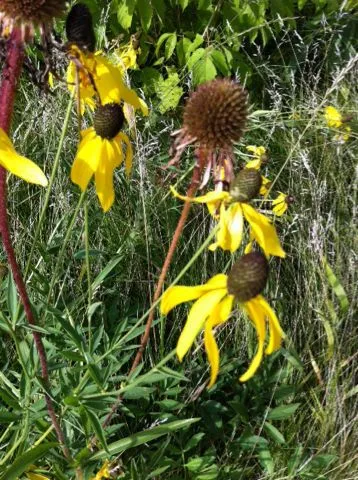
Author: Barnhart
Bibliography: Bull. Torrey Bot. Club 24(8): 410 (1897)
Year: 1897
Status: accepted
Rank: species
Genus: Ratibida
Vegetable: False
Observations: SE. Canada to NC. & E. U.S.A.
Drooping prairie-coneflower, known scientifically as Ratibida pinnata, is a distinctive and beautiful member of the Asteraceae family. It captures attention with its unique floral structure and widespread presence across regions of southeastern Canada, down to North Carolina, and throughout the eastern United States.
This perennial herbaceous plant is celebrated for its drooping yellow petals that surround a prominent, elongated central cone, which turns from green to brown as the plant matures. Standing on tall, slender stems that can reach heights of up to five feet, the Ratibida pinnata creates an elegant, airy display in prairies, meadows, and open woodlands where it naturally thrives.
The foliage of the drooping prairie-coneflower adds to its graceful appearance. The pinnately divided leaves are arranged alternately along the stem, further accentuating the tall and lean stature of the plant. The leaves are typically deep green, creating a contrasting backdrop that allows the vibrant yellow flowers to shine.
Ratibida pinnata is not only a visual delight but also an important ecological component. It attracts a variety of pollinators, including bees, butterflies, and other beneficial insects, making it an excellent choice for gardeners looking to support local ecosystems. Its hardiness and adaptability to different soil conditions, as well as its drought tolerance, make it a versatile addition to both naturalized and cultivated landscapes.
Historically described in 1897 by Barnhart, as noted in the Bulletin of the Torrey Botanical Club, the drooping prairie-coneflower has been a subject of interest for botanists and plant enthusiasts alike. Its resilience and aesthetic qualities continue to earn it a place in various botanical gardens and restoration projects across its native range.
In summary, the drooping prairie-coneflower is a lovely and functional plant that enhances biodiversity, supports pollinators, and brings a touch of wild beauty to gardens and natural areas.
Eng: drooping prairie-coneflower, gray-head prairie-coneflower, grayhead or pinnate prairie coneflower, pinnate prairie coneflower, pinnate prairie-coneflower, pinnate-leaf prairie-coneflower, grey-headed coneflower, grey-headed prairie coneflower
Deu: nickender prairiesonnenhut
Swe: stor mexikohatt
Fra: ratibida à feuilles pennées
En: Drooping prairie-coneflower, Gray-head prairie-coneflower, Pinnate prairie-coneflower, Pinnate-leaf prairie-coneflower, Pinnate prairie coneflower, GRAYHEAD PRAIRIECONEFLOWER, Grayhead or pinnate prairie coneflower, Grey-headed coneflower, Grey-headed prairie coneflower
Fi: Preeriakeltahattu
Fr: Ratibida à feuilles pennées
De: Nickender Prairiesonnenhut
Sv: Stor mexikohatt
Taken Jul 11, 2021 by David Koser (cc-by-sa)
Taken Jul 27, 2021 by Jordan Wallin-Swanson (cc-by-sa)
Taken Jul 27, 2022 by Joseph Martin (cc-by-sa)
Taken Jul 22, 2021 by K O (cc-by-sa)
Taken Jul 28, 2020 by Thierry Thierry Bessière (cc-by-sa)
Taken Aug 4, 2015 by EOL − Brianne Nelson (cc-by-nc)
Taken Aug 6, 2015 by EOL − Aarongunnar (cc-by-nc)
Taken Aug 3, 2015 by EOL − Lynn Michael (cc-by-nc)
Taken Jul 13, 2015 by EOL − Christine (cc-by-nc)
Taken Jul 17, 2015 by EOL − Aarongunnar (cc-by-nc)
Taken Jan 1, 1900 by EOL − John Hilty (cc-by-nc)
Taken Jun 1, 2006 by EOL − Darel Hess (cc-by-nc-sa)
Taken Aug 30, 2014 by EOL − Fluff Berger (cc-by-sa)
Taken Aug 12, 2015 by EOL − Jenny Smith (cc-by-nc)
Taken Jul 26, 2022 by megan allsup (cc-by-sa)
Taken Oct 23, 2022 by Werner Rom (cc-by-sa)
Taken Jun 30, 2010 by EOL − Ron Thomas (cc-by-nc-sa)
Taken Oct 23, 2022 by Werner Rom (cc-by-sa)
Taken Sep 15, 2013 by EOL − Erin Faulkner (cc-by-nc)
Taken Sep 4, 2021 by Murphy Patrick (cc-by-sa)
Taken Aug 10, 2020 by Alex Mas (cc-by-sa)
Growth form>: Single Crown
Growth habit>: Forb/herb
Growth rate>: Moderate
Ph maximum: 6.8
Ph minimum: 5.6
Family: Myrtaceae Author: (F.Muell.) K.D.Hill & L.A.S.Johnson Bibliography: Telopea 6: 402 (1995) Year: 1995 Status:…
Family: Rubiaceae Author: Pierre ex A.Froehner Bibliography: Notizbl. Bot. Gart. Berlin-Dahlem 1: 237 (1897) Year:…
Family: Sapindaceae Author: Koidz. Bibliography: J. Coll. Sci. Imp. Univ. Tokyo 32(1): 38 (1911) Year:…
Family: Asteraceae Author: A.Gray Bibliography: Pacif. Railr. Rep.: 107 (1857) Year: 1857 Status: accepted Rank:…
Family: Fabaceae Author: Medik. Bibliography: Vorles. Churpfälz. Phys.-Ökon. Ges. 2: 398 (1787) Year: 1787 Status:…
Family: Aspleniaceae Author: (Cav.) Alston Bibliography: Bull. Misc. Inform. Kew 1932: 309 (1932) Year: 1932…